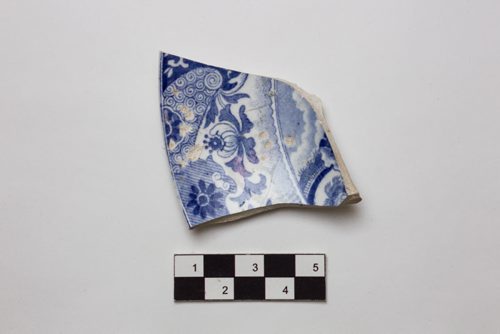
Photo description:
Scott Stephen, an historian at Parks Canada, showcases a few artifacts in the collections at the Parks Canada office in Winnipeg that were recovered from various digs at the forks and area. Bowl, Blue Italian pattern, earthenware (21K17F7-1): Recovered from North Point in 1988 from fur trade fill. The Italian pattern was introduced by Spode Copeland around 1816 and immediately gained popularity; it remains a popular pattern produced today. The border motif is a copy of an Imari design, used on Chinese export porcelain dating from about 1735. Known as a transfer-print decorative treatment, the Italian pattern was engraving on a copper plate then applying a metallic oxide pigment to the engraved plate produced the pattern. The pattern was printed onto tissue paper then the paper print while still wet was applied to the bowl leaving the desired imprint. A clear glaze was then applied over the pattern and the bowl re-fired to vitrify the glaze and create the blue coloured-design. Spode Copeland, a ceramic manufacturer located in England, exported many products to Canada and was a key supplier to the Hudsons Bay Company from 1836 when William Taylor Copeland worked in partnership with Thomas Garrett and the company was known as Copeland and Garrett (1833-47). In 1847 William T. Copeland went into business for himself and in 1867 his sons joined him to form the company W.T. Copeland and Sons. The company name changed to Spode Limited in 1970 and it is still in business today. Although the bowl is not marked with manufacturers name, given the context it was found, and the identifiable pattern, it is highly likely it was made at the Copeland factory. 150924 - Thursday, September 24, 2015 - MIKE DEAL / WINNIPEG FREE PRESS
Order this photoOrder Form

Open Close Prints
High quality Winnipeg Free Press prints delivered right to your door!
5x7 Print
$15.00
8x10 Print
$17.00
8x12 Print
$18.00
11x14 Print
$23.00
16x20 Print
$33.00
16x24 Print
$35.00
20x24 Print
$40.00

